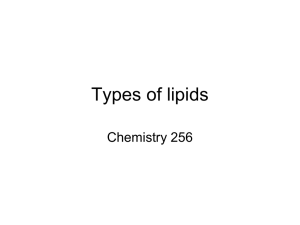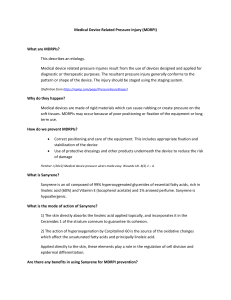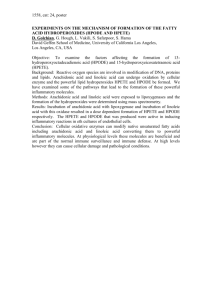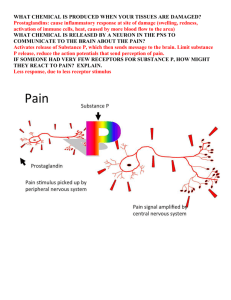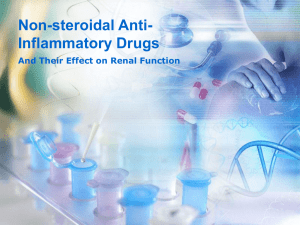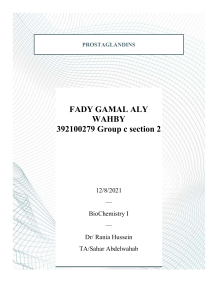Kevin Ahern's Biochemistry (BB 451/551) at Oregon State University
advertisement
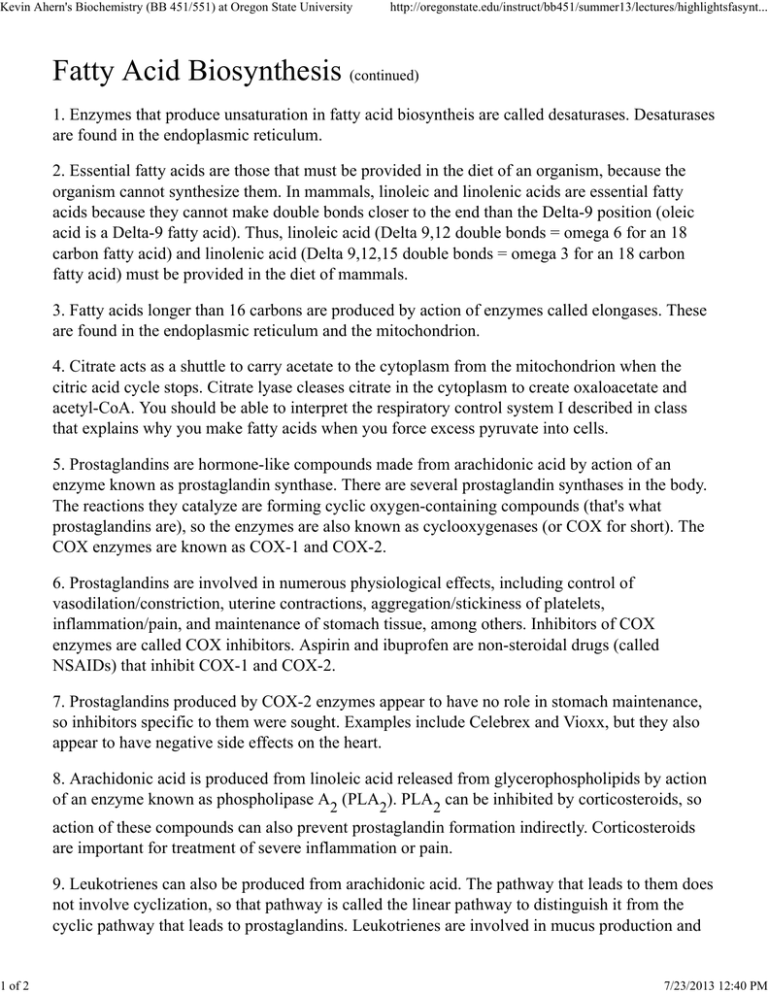
Kevin Ahern's Biochemistry (BB 451/551) at Oregon State University http://oregonstate.edu/instruct/bb451/summer13/lectures/highlightsfasynt... Fatty Acid Biosynthesis (continued) 1. Enzymes that produce unsaturation in fatty acid biosyntheis are called desaturases. Desaturases are found in the endoplasmic reticulum. 2. Essential fatty acids are those that must be provided in the diet of an organism, because the organism cannot synthesize them. In mammals, linoleic and linolenic acids are essential fatty acids because they cannot make double bonds closer to the end than the Delta-9 position (oleic acid is a Delta-9 fatty acid). Thus, linoleic acid (Delta 9,12 double bonds = omega 6 for an 18 carbon fatty acid) and linolenic acid (Delta 9,12,15 double bonds = omega 3 for an 18 carbon fatty acid) must be provided in the diet of mammals. 3. Fatty acids longer than 16 carbons are produced by action of enzymes called elongases. These are found in the endoplasmic reticulum and the mitochondrion. 4. Citrate acts as a shuttle to carry acetate to the cytoplasm from the mitochondrion when the citric acid cycle stops. Citrate lyase cleases citrate in the cytoplasm to create oxaloacetate and acetyl-CoA. You should be able to interpret the respiratory control system I described in class that explains why you make fatty acids when you force excess pyruvate into cells. 5. Prostaglandins are hormone-like compounds made from arachidonic acid by action of an enzyme known as prostaglandin synthase. There are several prostaglandin synthases in the body. The reactions they catalyze are forming cyclic oxygen-containing compounds (that's what prostaglandins are), so the enzymes are also known as cyclooxygenases (or COX for short). The COX enzymes are known as COX-1 and COX-2. 6. Prostaglandins are involved in numerous physiological effects, including control of vasodilation/constriction, uterine contractions, aggregation/stickiness of platelets, inflammation/pain, and maintenance of stomach tissue, among others. Inhibitors of COX enzymes are called COX inhibitors. Aspirin and ibuprofen are non-steroidal drugs (called NSAIDs) that inhibit COX-1 and COX-2. 7. Prostaglandins produced by COX-2 enzymes appear to have no role in stomach maintenance, so inhibitors specific to them were sought. Examples include Celebrex and Vioxx, but they also appear to have negative side effects on the heart. 8. Arachidonic acid is produced from linoleic acid released from glycerophospholipids by action of an enzyme known as phospholipase A2 (PLA2). PLA2 can be inhibited by corticosteroids, so action of these compounds can also prevent prostaglandin formation indirectly. Corticosteroids are important for treatment of severe inflammation or pain. 9. Leukotrienes can also be produced from arachidonic acid. The pathway that leads to them does not involve cyclization, so that pathway is called the linear pathway to distinguish it from the cyclic pathway that leads to prostaglandins. Leukotrienes are involved in mucus production and 1 of 2 7/23/2013 12:40 PM Kevin Ahern's Biochemistry (BB 451/551) at Oregon State University http://oregonstate.edu/instruct/bb451/summer13/lectures/highlightsfasynt... bronchial constriction and play important roles in causing asthma attacks. 10. Another class of molecules made from prostaglandins is the thromboxanes. These molecules help to make platelets "sticky", favoring aggregation. Thus, taking aspirin reduces synthesis of prostaglandins, which in turn reduces amounts of thromboxanes, which reduces stickiness of platelets, which makes it harder for blood to clot. It is for this reason that people prone to clotting problems are advised to take aspirin daily. 2 of 2 7/23/2013 12:40 PM
